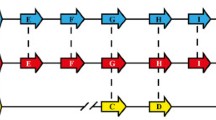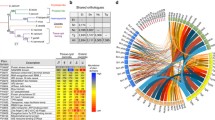Abstract
The higher intergenotypic polymorphism of the surface antigen genes 5 (SAG5)A, SAG5C, and SAG5E in Toxoplasma gondii was proposed to be the outcome of positive selection pressure favoring variation within these loci. However, the exact nature and magnitude of this selection is not completely known. To address this issue, the amino acids on which natural selection may operate were identified by comparing the ratios of nonsynonymous and synonymous substitutions (p N/ p S) of homologous DNA sequences in strains belonging to the three major genotypes of T. gondii. Both positive and negative selections were detected and are likely to have contributed to shaping the patterns of nucleotide substitution and polymorphism in SAG5 genes. Several sites identified in SAG5 loci as likely to be under positive selection suggesting that diversifying selection may have promoted divergence in these genes. Also, it was noted that the SAG5 genetic loci contain many areas that exhibit signs of purifying selection; some of these areas might be the attractive candidates for drug targets. Phylogenetic analysis using the neighbor-joining and maximum parsimony methods grouped the SAG5 sequences of T. gondii strains into three distinct statistically well-supported evolutionary lineages. These findings carry important implications for human and veterinary toxoplasmosis epidemiology and may provide important insights into the pathways through which virulence has evolved in T. gondii.



Similar content being viewed by others
References
Elsheikha HM, Mansfield LS (2004) Sarcocystis neurona major surface antigen gene 1 (SAG1) shows evidence of having evolved under positive selection pressure. Parasitol Res 94:452–459
Endo T, Ikeo K, Gojobori T (1996) Large-scale search for genes on which positive selection may operate. Mol Biol Evol 13:685–690
Fu YX, Li WH (1993) Statistical tests of neutrality of mutations. Genetics 133:693–709
Kosakovsky Pond SL, Frost SDW (2005) Not so different after all: a comparison of methods for detecting amino acid sites under selection. Mol Biol Evol 22:1208–1222
Kumar S, Tamura K, Nei M (2004) MEGA3: integrated software for molecular evolutionary genetics analysis and sequence alignment. Brief Bioinform 5:150–163
McCabe RE, Remington JS (1990) Toxoplasma gondii. In: Mandell GL, Douglas RG Jr, Bennett JE (eds) Principles and practices of infectious diseases. 3rd edn. Churchill Livingstone, Inc., New York, NY, pp 2090–2103
McLeod R, Remington JS (1991) Toxoplasmosis. In: Wilson JD, Braunwald E, Isselbacher KJ, Petersdorf RG, Martin JB, Fauci AS, Root RK (eds) Harrison's principles of internal medicine. McGraw-Hill, New York, NY, pp 879–885
Nei M, Gojobori T (1986) Simple methods for estimating the numbers of synonymous and nonsynonymous nucleotide substitutions. Mol Biol Evol 3:418–426
Nei M, Kumar S (2000) Molecular evolution and phylogenetics. Oxford University Press, New York, NY
Ohta T (1991) Cirumsporozoite protein genes of malaria parasites (Plasmodium spp.): evidence for positive selection on immunogenic regions. Genetics 127:345–353
Rozas J, Sanchez-DelBarrio JC, Messeguer X, Rozas R (2003) DnaSP, DNA polymorphism analyses by the coalescent and other methods. Bioinformatics 19:2496–2497
Spano F, Ricci I, Di Cristina M, Possenti A, Tinti M, Dendouga N, Tomavo S, Crisanti A (2002) The SAG5 locus of Toxoplasma gondii encodes three novel proteins belonging to the SAG1 family of surface antigens. Int J Parasitol 32:121–131
Tajima F (1989) Statistical method for testing the neutral mutation hypothesis by DNA polymorphism. Genetics 123:585–595
Tarr CL, Whittam TS (2002) Molecular evolution of the intimin gene in O111 clones of pathogenic Escherichia coli. J Bacteriol 184:479–487
Thornton JW, DeSalle R (2000) Gene family evolution and homology: genomics meet phylogenetics Ann. Rev. Genomics Human Genet 1:41–73
Tinti M, Possenti A, Cherchi S, Barca S, Spano F (2003) Analysis of the SAG5 locus reveals a distinct genomic organisation in virulent and avirulent strains of Toxoplasma gondii. Int J Parasitol 33:1605–1616
Van der Ende A, Pan Z, Bart A, Van der Hulst RWM, Feller L, Xiao S, Tytgat GNJ, Dankert J (1998) cagA-Positive Helicobacter pylori populations in China and The Netherlands are distinct. Infect Immun 66:1822–1826
Acknowledgments
The authors gratefully acknowledge David W. Lacher (Michigan State University) for the technical advice. PSWIN program is written and kindly provided by Dr. Thomas S. Whittam (Microbial Evolution Laboratory, National Food Safety and Toxicology Center, Michigan State University, East Lansing, MI 48824, USA).
Author information
Authors and Affiliations
Corresponding author
Rights and permissions
About this article
Cite this article
Elsheikha, H.M., Zhao, X. Patterns and role of diversifying selection in the evolution of Toxoplasma gondii SAG5 locus. Parasitol Res 103, 201–207 (2008). https://doi.org/10.1007/s00436-008-0958-8
Received:
Accepted:
Published:
Issue Date:
DOI: https://doi.org/10.1007/s00436-008-0958-8




